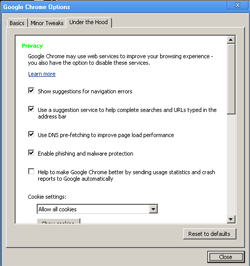When Google first released Chrome back in September 2008, I carried out a quick and dirty accessibility analysis of it. With the release of Google chrome 2.0 I though it worthwhile to have another look to see what improvements have been made. While there has been progress, for many users with disabilities, Google Chrome is still unusable.
Keyboard Operability Improvements
The Chrome Assistive Technology Support document states “All functionality in the toolbar should be accessible from the keyboard alone (please report any bugs, if found).”
The toolbar controls and menus are now navigable using the keyboard shortcut SHIFT+ALT+T to set focus on the toolbar. Use right and left arrows on the keyboard to navigate to different buttons on the toolbar.
There are still a number of outstanding keyboard accessibility issues, which are being worked on and others that currently have no resources assigned to their resolution.
OS Accessibility Options Support
Google Chrome still does not support Windows High Contrast mode color settings for the main browser interface and web pages, I thought initially that high contrast color support for dialogs had improved, but realized that this was due to some text labels now being totally obscured rather than the text being fuzzy. Unfortunately the High Contrast mode support is not being actively worked on.


Exposure of Name,Role and State information
Google Chrome Interface
The mapping of the various controls and widgets, that make up chrome’s chrome, to the MSAA accessibility API has improved. Technical details are available in the Chrome Assistive Technology Support Implementation Roadmap – Windows.
Google Chrome Web Content
Due to the multi-process architecture of Chrome, the MSAA implementation here is a bit more complex than normally required.
The MSAA implementation is still being worked on by Jonas Klink. It is by no means complete, but it’s current state can be checked in the latest build of Chromium by using a flag (chrome.exe –enable-renderer-accessibility) to turn on MSAA support. The technical details of current support and issues is available in the Implementation Roadmap – Windows
WAI-ARIA Support
Supporting whatever ARIA is currently implemented in WebKit, and exposed through their MSAA.
Recent testing of WebKit support for WAI-ARIA indicates that implementation is currently limited to ARIA roles that map to native HTML controls (See results for Safari).
Conclusion
The current verion of Google Chrome does not have the basic support required for accessibility. Support is in development, but Google needs to dedicate more resources if they are going to provide a browser, any time soon, that rivals Firefox or Internet Explorer in terms of accessibility for users with disabilities.
